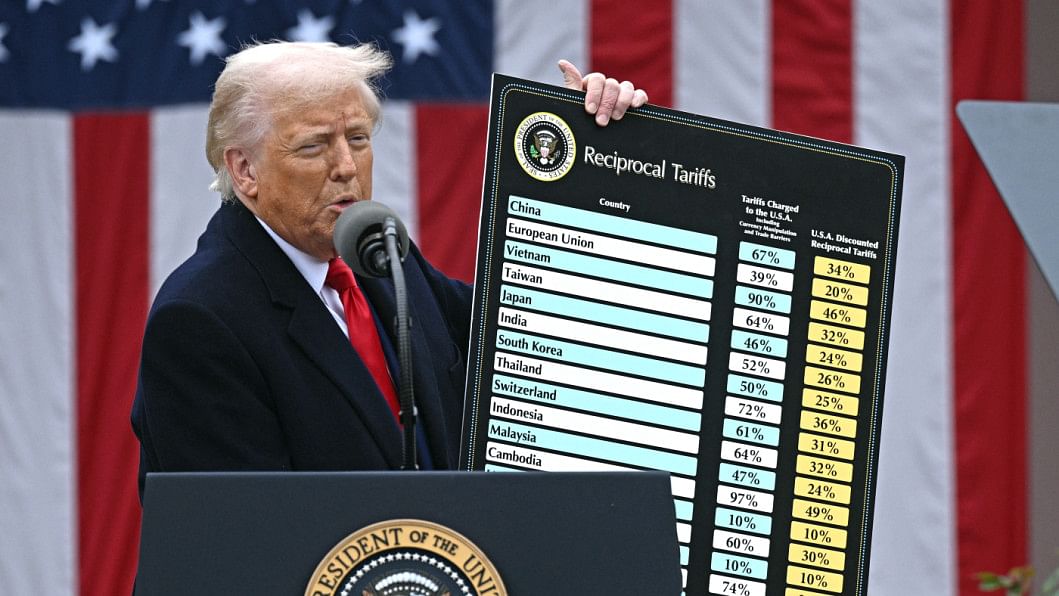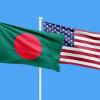US tariffs: thorn in the side or blessing in disguise?

Causing some trepidation in the hearts of Bangladesh's readymade garment (RMG) sector leaders is the newly imposed 37 percent tariff by the United States on Bangladeshi imports. The move comes just as the economy was finding its feet after a regime change, making it a moment of critical reflection for the industry.
Although not entirely disheartening, the tariff makes it clear that Bangladesh must act fast to reduce the bilateral trade deficit. Enhancing efficiencies could help regain momentum with its largest buyer and improve long-term sustainability in global trade.
Bangladesh is not alone in facing US trade penalties. Other affected countries include China (54 percent), Vietnam (46 percent), Cambodia (49 percent), Indonesia (32 percent), Pakistan (29 percent), Mexico (25 percent), Honduras (10 percent), and India (26 percent). Tariffs vary depending on each country's trade deficit with the US.
Bangladesh's deficit stands at $6.2 billion. For comparison, China's trade deficit with the US was $295.4 billion as of 2024, followed by Vietnam at $123.5 billion and Mexico at $171.8 billion. These numbers offer a glimpse into how the US may be calculating its trade defence strategy.
Initially, the outlook appeared simple — with rivals facing higher tariffs, Bangladesh could potentially gain more orders. However, upon deeper analysis, the situation is far more nuanced and requires strategic planning to seize any real advantage.
Bangladesh has been trying to break into mid- and high-end markets. Yet, its core strength remains in low- and mid-range garments, thanks to labour intensity, economies of scale, and competitive wages, despite ongoing productivity challenges compared to its peers.
The US heavily relies on low- and mid-range imports, which Bangladesh primarily supplies.
With fewer countries capable of bulk production in these categories, Bangladesh could become an attractive alternative, especially as Chinese, Vietnamese, and Cambodian goods face higher tariffs.
To illustrate the tariff impact, let us consider a product priced at $5 exported from both China and Bangladesh.
The tariff gap of approximately 17 percent means a price difference of $0.85 per unit, which could significantly benefit Bangladeshi exports while harming Chinese ones.
Such gaps, although small in unit terms, matter immensely in bulk orders — the bread and butter of RMG exporters.
In 2024, the US imported $80 billion worth of RMG. Of that, China, Vietnam, and Cambodia — the hardest hit by tariffs — together contributed about $35 billion. Naturally, there's a looming question: who will benefit from this shift in sourcing?
While India and Pakistan are also potential beneficiaries, their limited production capacities may restrict how much of this shifting demand they can absorb. India's total RMG exports stood at $15.72 billion, with only $4.69 billion going to the US. Pakistan exported $8.33 billion in total, with $2.16 billion to the US.
With tight resources and limited infrastructure, these countries may target higher-value orders redirected from China or Vietnam. For example, India could win specialised woven items, while Pakistan might pick up denim. That leaves the basic product orders — where Bangladesh excels — up for grabs.
Shifting orders to new players like Ethiopia, Jordan, or Kenya also won't be easy. These countries still lack the production scale needed to absorb high-volume orders, despite some of them enjoying duty-free access in the past.
Honduras and Mexico, which will now face 10 and 25 percent tariffs respectively, don't pose a large threat either. Honduras, with a $2.3 bn export to USA will now face base tariffs of at least 10% while Mexico, with a $2.6 bn will face 25%.
While Honduras is poised to receive a rise in business, especially considering the low tariffs and export lead time, the amount of business expected to go there is not enough to threaten Bangladesh.
Turkey, with its 10 percent tariff and focus on high-value products, also does not directly compete with Bangladesh's low- and mid-tier offerings. With about 9 percent of the US garment market already in its pocket, Bangladesh is still a major player in the sector.
That said, US consumers may start scaling back purchases due to price hikes. This could temporarily impact Bangladesh's export volumes in the short term.
Indonesia, facing a 32 percent tariff and with $7.34 billion in US-bound exports in 2024, is now considered expensive. This could give Bangladesh an opening, especially in non-cotton product categories, where the market is currently underserved.
However, Bangladesh must urgently reduce the trade imbalance with the US to ensure long-term sustainability.
Non-tariff trade barriers flagged by the Office of the United States Trade Representative (USTR) as of February 2025 include customs procedures, procurement practices, IP laws, e-commerce regulations, investment hurdles, labour issues, and even corruption.
Overcoming these non-tariff barriers is crucial. Doing so could unlock the path to long-term efficiency and competitiveness — both of which Bangladesh needs, not just to survive the tariff storm, but to thrive after its LDC graduation.
Enhancing infrastructure, fixing the financial sector, and considering currency devaluation may be necessary. Buyer confidence also depends on product safety, reliable supply chains, and improved production lead times — all areas Bangladesh must prioritise.
Bangladesh's export mix — 70 percent cotton, 30 percent non-cotton — could be strategically tweaked. With rising US demand for non-cotton products and China, Cambodia, and Vietnam now costlier, Bangladesh has a real shot at gaining more orders.
Still, addressing trade deficits goes beyond just tariff cuts. Countries must improve overall competitiveness to benefit from any policy changes. Bangladesh's relatively lower trade deficit compared to others could work in its favour — but only with the right reforms.
Buyers may try to pass the burden of tariffs onto Bangladeshi suppliers. So, calm, calculated decisions are key. The US may reassess these tariffs in four years, meaning today's choices must align with long-term interests.
There are also existing orders in production that buyers may try to renegotiate. Both sides must remain fair and flexible. Bangladesh's government must support affected factories so they can weather this temporary disruption.
Notably, Bangladesh is the fifth-largest importer of US cotton. This is a strategic advantage. Negotiators should leverage this fact and propose preferential treatment for products made from American cotton — a possible win-win.
Many factories in Bangladesh are deeply invested in US clients. Rash decisions under tariff pressure could jeopardise jobs and livelihoods. As Bangladesh approaches LDC graduation, with 19 percent of garment exports going to the US and 50 percent to the EU, diversification is essential.
This tariff storm is part of broader turbulence in global trade. Countries are scrambling to adapt. But Bangladesh has repeatedly proven its mettle — from surviving the Rana Plaza tragedy to the shocks of Covid-19. Its resilience is unmatched.
To maintain its hard-won position as the world's second-largest garment exporter, Bangladesh must commit to long-term, strategic reforms focused on boosting productivity, cutting lead time, and becoming a truly competitive global player.
The author is a former director of the Bangladesh Garment Manufacturers and Exporters Association

 For all latest news, follow The Daily Star's Google News channel.
For all latest news, follow The Daily Star's Google News channel. 








Comments